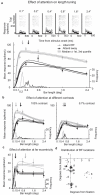Attention alters spatial integration in macaque V1 in an eccentricity-dependent manner
- PMID: 17906622
- PMCID: PMC2673551
- DOI: 10.1038/nn1967
Attention alters spatial integration in macaque V1 in an eccentricity-dependent manner
Abstract
Attention can selectively enhance neuronal responses and exclude external noise, but the neuronal computations that underlie these effects remain unknown. At the neuronal level, noise exclusion might result in altered spatial integration properties. We tested this proposal by recording neuronal activity and length tuning in neurons of the primary visual cortex of the macaque when attention was directed toward or away from stimuli presented in each neuron's classical receptive field. For cells with central-parafoveal receptive fields, attention reduced spatial integration, as demonstrated by a reduction in preferred stimulus length and in the size of the spatial summation area. Conversely, in cells that represented more peripheral locations, attention increased spatial integration by increasing the cell's summation area. This previously unknown dichotomy between central and peripheral vision could support accurate analysis of attended foveal objects and target selection for impending eye movements to peripheral objects.
Figures





References
-
- Haenny PE, Schiller PH. State dependent activity in monkey visual cortex. I Single cell activity in V1 and V4 on visual tasks. Exp.Brain Res. 1988;69:225–244. - PubMed
-
- Luck SJ, Chelazzi L, Hillyard SA, Desimone R. Neural mechanisms of spatial selective attention in areas V1, V2, and V4 of macaque visual cortex. J Neurophysiol. 1997;77:24–42. - PubMed
-
- Roelfsema PR, Lamme VA, Spekreijse H. Object-based attention in the primary visual cortex of the macaque monkey. Nature. 1998;395:376–81. - PubMed
-
- Spitzer H, Desimone R, Moran J. Increased Attention Enhances Both Behavioral and Neuronal Performance. Science. 1988;240:338–340. - PubMed
-
- Treue S, Maunsell JHR. Attentional modulation of visual motion processing in cortical areas MT and MST. Nature. 1996;382:539–541. - PubMed
Publication types
MeSH terms
Grants and funding
LinkOut - more resources
Full Text Sources

